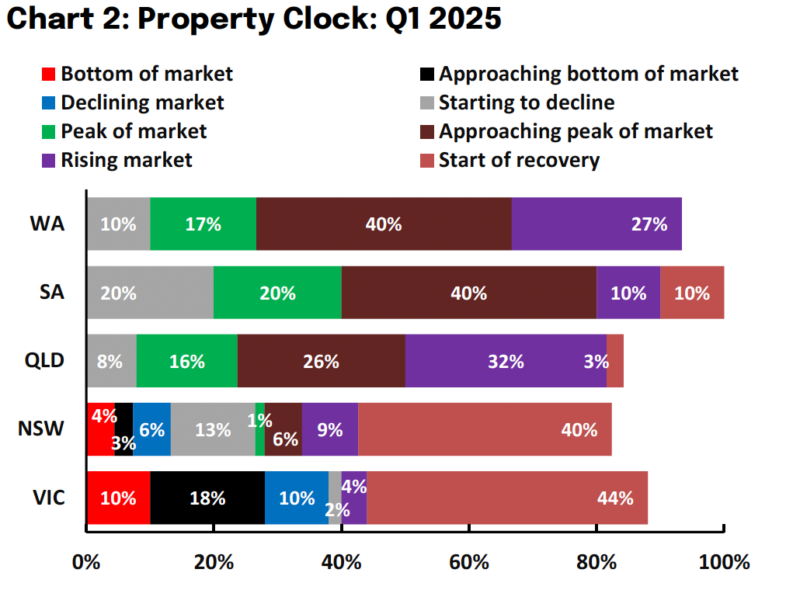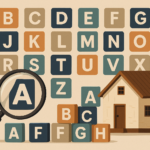
Key takeaways
Sentiment surges: NAB’s Residential Property Index jumped to +40, signalling a strong turnaround in market confidence after three soft quarters.
Interest rate cuts coming: NAB now expects the RBA to cut rates to 3.1% by Q3 and further to 2.6% by early 2026, supporting ongoing price growth.
House prices upgraded: Property professionals now forecast 2.3% growth over the next year, and 3.1% over the next two years.
Rent expectations lift: Despite a recent slowdown in annual growth, rents are expected to rise again, particularly in QLD and NT, due to tight supply.
Supply still constrained: Construction costs and planning delays—not interest rates—are now the biggest obstacles to new housing projects.
First Home Buyers retreating: FHBs are losing ground in both new and established markets, while owner-occupiers step up and dominate activity.
Investor activity down—but poised to recover: Local investors are still cautious, especially in VIC, but expectations are for a resurgence over the next year.
Foreign buyer activity spikes temporarily: A rush of foreign purchases ahead of the April 1 ban on buying established dwellings boosted Q1 numbers.
Now may be the time to act: With confidence rising, rates falling, and supply constraints persisting, savvy investors should consider moving early—before the market fully rebounds.
Interest rates are falling, confidence is rising, and property prices are stabilising.
This could actually be one of the best times in years to get into the property market.
According to NAB’s latest Residential Property Survey, Australia’s housing market has turned a significant corner.
After a challenging year of interest rate uncertainty and affordability headwinds, we’re now seeing a substantial rebound in confidence, with national sentiment lifting strongly—particularly in key resource-rich and lifestyle states.
NAB economist Sally Auld expects the RBA would cut the cash rate by 50 basis points in May, followed by 25 basis point cuts in July, August, November and February.
he major bank is expecting five cuts in this rate-cutting cycle, with the central bank needing to “catch up” with recent global developments.
This would take the cash rate down to 2.6 per cent and shave an estimated $526 off monthly repayments for the average $600,000 loan.
While many buyers remain hesitant, savvy investors are quietly positioning themselves ahead of the next wave.
Sentiment Bounces Back Across the Country
The NAB Residential Property Index jumped from +16 to +40 in Q1, marking a decisive turnaround from three consecutive quarters of decline.
This is significant, not just because it’s well above the long-term average, ut because it reflects widespread recovery sentiment.
-
NT (+100) and SA (+80) led the surge, both seen as approaching the peak of their respective market cycles.
-
NSW (+31) and VIC (+16) are back in positive territory, but sentiment there still trails other states as these markets begin their recovery phase.
-
The ACT remains the outlier with sentiment still in negative territory (-25), likely reflecting weaker price growth and limited buyer activity.

In practical terms? The momentum is shifting, and investor psychology is improving—a key driver for future capital growth.
Price Growth Upgraded as Interest Rates Set to Fall Further
NAB now expects capital city dwelling values to rise by 3.3% in 2025 and a stronger 5.6% in 2026, with falling interest rates providing much of the tailwind.
They anticipate the RBA to cut rates to 3.1% by Q3 2025 and then further to 2.6% in early 2026.
NAB executive chief economist Sally Auld expects easing interest rates to support growth and the economy to have a “soft landing” with inflation settling around the middle of the RBA’s target band by the second half of this year and unemployment staying below 4.5pc.
“That said, there are building headwinds in the global economy and shifts in US trade policy are likely to be net disinflationary for Australia.
Consequently, the RBA will need to normalise rates quickly to ensure policy is appropriately calibrated. We now see the RBA cutting to 3.1pc by August and then taking the cash rate to 2.6pc by early-2026.”
The cash rate target was last at 2.6pc in October 2022 – which was at the tail end of pandemic lockdowns.
The latest survey found house price growth expectations for the coming 12 months had almost doubled, at 2.3pc (1.2pc previously) while property professionals were also expecting rent growth to accelerate in the coming year (2.2pc vs 1.6pc previously).
Rental Growth Expectations Lift Again Despite Slowing Annual Data
Even though CoreLogic’s rental data shows annual growth easing to 3.1% (down from 9.7% in late 2021), NAB’s survey respondents believe the rental market isn’t done yet.
Expectations for rent increases:
-
Next 12 months: 2.2% (was 1.6%)
-
Next 2 years: 2.7% (was 2.6%)
The biggest expected gains are in NT and QLD, while VIC and ACT are expected to underperform.
Importantly, rental undersupply is still the dominant theme—WA (-97%), SA (-90%) and QLD (-87%) all report extreme shortages of rental stock
Barriers to Development: Not What You Might Expect
There’s a big misconception out there that high interest rates are still the primary roadblock to new housing supply.
Not anymore.
According to NAB, the two major culprits now are:
-
Construction costs (71%)
-
Planning permit delays (62%)
Only 8% of respondents now cite interest rates as a major constraint, and just 15% flagged housing affordability (down sharply from 41%).
The message is clear: while rates may be easing, structural supply issues persist and will continue to limit the number of new dwellings coming online.
For investors, that means limited new supply + improving sentiment = upward price pressure.
First Home Buyers Retreat, But Owner Occupiers Step Up
FHBs pulled back slightly in Q1:
-
Down to 34.2% of new home market share (from 38.2%)
-
Down to 32.8% of total established market sales (from 35.5%)
Owner-occupiers (excluding FHBs), however, now dominate the market:
-
46.2% of established sales—the highest in 3 years.
Meanwhile, local investors have retreated slightly—down to 15.9%, with particularly weak participation in VIC (9.1%).
This soft investor activity suggests there’s still time to enter before the next big wave.
When the herd returns, yields will compress, and prices will be chasing themselves up again.
And early next year when Labor's First Home Buyer scheme will allow FHB's to purchase a property with just 5% deposit, there will be a surge of buyers entering the sub $1million markets.
Foreign Buyers Surge (Temporarily?) Ahead of Government Ban
One of the more intersting trends in this quarter's report was the jump in foreign buyer activity:
-
New properties: 6.9% of market share (up from 4.8%)
-
Established homes: 3.1% (up from 2.8%)
But there’s a catch: the spike is likely in anticipation of the federal government’s ban on foreign purchases of existing dwellings, which kicked in on April 1st, 2025.
Expect these numbers to fall back in Q2—potentially opening more opportunities for local investors to compete for established homes.
Final Thoughts: What Should Savvy Investors Do Now?
This NAB survey marks a real shift in the market narrative.
-
Confidence is recovering.
-
Rate cuts are on the way.
-
Prices are already lifting in key markets.
-
Rental demand remains tight.
-
And we still aren’t building fast enough.
From a strategic investor’s perspective, this is classic countercyclical territory.
When mainstream sentiment is still cautious but forward-looking indicators are improving, that’s your window of opportunity.
At Metropole, we’ve always believed that successful investing is about understanding cycles, acting with clarity when others are uncertain, and buying the right property in the right location—not just chasing what's hot.
This report confirms that the right time to act may be sooner than many realise.
Why not take action and click here now and organise a complimentary Wealth Discovery consultation with a Metropole Wealth Strategist?
















